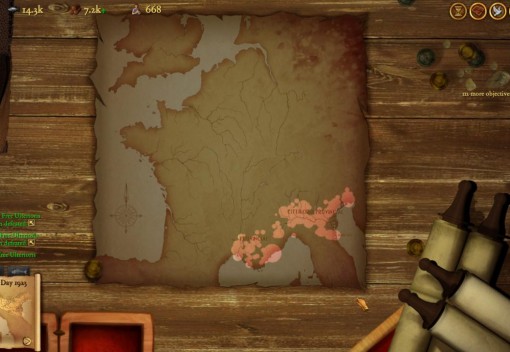Hegemony Rome: The Rise of Caesar Review
Hegemony Gold: Wars of Ancient Greece was easily one of my favorite real-time strategy games. It was rough, but it captivated me with some of the freshest ideas I'd seen in a while. Hegemony Rome drops almost all of the cleverness of its predecessor and replaces it with a lackluster facsimile poorly concealing an almost hollow frame.
Hegemony Rome: The Rise of Caesar follows one of history's most prolific conquerors through his Gallic campaign and the political aftermath. The game's story mode captures only a few of the really big historical moments, but it helps serve as a primer for the sandbox mode, which gives you all of Gaul and Southern Britain to play with. From there, you build up cities, gather resources, and expand--all typical of an average RTS game.
What makes the Hegemony series different from most is its attention to historical accuracy. It plays as somewhat of a cross between Europa Universalis and the Total War series. You spend a lot of time managing the minute details of your cities and forts, but you can also seamlessly zoom back out to a wide-area view that shows where all of the key points of interest are. In that sense, it's a lot smoother than Total War, which basically plays out as two games, one strategic and one tactical. In Hegemony Rome, you have one big map with two ways of looking at it. Unfortunately, while that system is great for quickly navigating from one battle to another across the map, it can be a bit unwieldy. As you pull the camera back, the texture of the large-scale paper map begins to replace the trees, mountains, and fields a bit too quickly, cutting off indicators for troop morale and circumstantial bonuses (such as flanking and charging). Because neither view offers up all of the information you need at any given point, a system that should be a boon often comes off as an annoyance.
The big draws of Hegemony Gold were troop management and logistics, and in these areas, it can be defined as a counterexample to other games of its type. In Starcraft, you didn't really need to manage supplies for your troops. You had a big pool, and every unit you built took from that pool. No additional management was required. Hegemony Gold was quite different. Not only did you have global resource totals that represented the theoretical maximum of your empire, but you also had to move those resources from city to city. If you were building up a big force to capture a new city, wherever you stationed your soldiers needed to have enough resources to keep them fed and happy, or you'd see them dissolve within a few minutes. That mechanic was reinforced by an entire system of troop formations, stances, and tactics that not only raised the stakes of proper administration but also felt cohesive and sturdy.

Hegemony Rome keeps a few of those concepts, but also waters them down to the point of near irrelevance. The emphasis here is on the supply lines themselves and making sure you have an efficient network of resource nodes to transport food, wood, and gold. Large forces still drain local resources pretty quickly, but that's rarely a problem. Hegemony Gold, however, limited the total number of resources that could move through any given area, unless upgraded. Each upgrade cost a lot to construct and maintain and forced you to make careful decisions about the best way to move resources around. Each city and resource node could also support only two or three supply lines, making your decisions that much more significant.
Hegemony Rome has almost none of these subtleties. All of your supplies can support an enormous resource flow, and only the foolishly long routes incur high penalties. They cost a fixed amount to maintain and cannot be upgraded, and you can make as many of them as you'd like. Their role is to support a fairly simple system of city and fort upgrades, but the mechanics behind this upgrade system are no longer robust enough to be compelling or interesting. Instead, the system encourages you to build up complex webs of short, cheap supply lines that minimize global losses. That makes the game extremely tedious, however, because forts, bridges, and cities need to be linked and bunched really close together. Tactics and big strategy take a backseat to tedium and rote patterns.
Every city is captured in more or less the same way. With a scout or two, you can get an eye for how strong the defenses are, and if the defense rating is below a certain number, you can be reasonably sure that you can capture the city in one go. If it's above a certain number, you simply have to starve the citizens out by blocking their supply lines and waiting. Once that's done, you get the new acquisition connected to your trade network, get a few upgrades in, leave a garrison, recruit a few new units, and keep the push going. Occasionally, you encounter a unique situation where the city is nestled in a cliff and you can use only a few units to attack versus your standard five or so. Outside of that, though, there's very little to mix up the combat.

Part of the problem is that there are no longer troop formation options. Instead of forming a chevron pattern or having your units stand in a circle with spears facing outward for defense, you typically choose one of two stances. Now, these offer similar bonuses to battle formations, but with only two options, there isn't enough variance to do much of anything. In the first Hegemony, I could have troops stationed in the wilderness and have them constantly gathering a little bit of food. If enemies approached, they assumed a defensive battle formation and stood their ground. If the opposing force was too much, playing defensively would at least buy me enough time to move cavalry in a wedge formation to break enemy ranks and cause them to scatter. When I would siege enemy cities, I would often find that they had kept some extra units nearby to ambush and flank attackers. These were complex, emergent battle tactics that were facilitated by the game's mechanics. That kind of complexity doesn't happen anymore. Too much has been cut out, and not enough added back in to compensate. The only thing that is more robust in Hegemony Rome is the expansion of unit upgrades. As your soldiers fight and earn experience, they can gain skills that improve their maximum morale, or they can add more soldiers to their ranks. These upgrades are nice, but they're not enough to help fill out such a large game.
At this point, I've put more than 24 hours into Hegemony Rome, but I feel like it's waging some kind of psychological warfare on me. Outside of the first couple of hours, I've gone through the exact same process: expand, fortify, hold, lather, rinse, repeat. It's remarkably addictive, but in a cheap, Skinner box way. There's nothing to improve upon, so I'm not compelled to try harder. I just keep capturing things.
I went back a few times recently to play the first Hegemony to see if I just had huge nostalgia glasses for the series. I didn't. Hegemony Gold really is that much better. Everything from the user interface to the unit AI was and still is superior. To be fair, not every game needs to live up to its predecessor, but Rise of Caesar can't even stand on its own. Almost everything here is mediocre, and that's really a shame given the promise of Wars of Ancient Greece.









